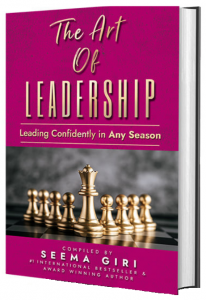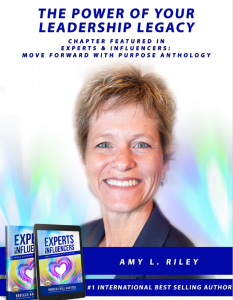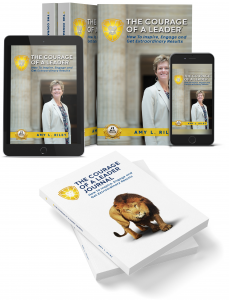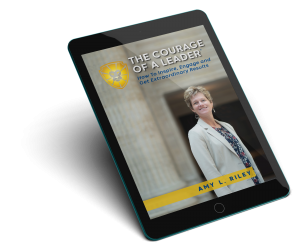In over 2 decades of developing leaders at all levels, I’ve noticed that whenever I have been inspired or impressed by a leader, that leader was demonstrating personal courage. They were doing the internal work in order to be able to create amazing results out in the world.
In this episode, I tell you some of those stories of when I was inspired and impressed.
About the Host:
Amy L. Riley is an internationally renowned speaker, author and consultant. She has over 2 decades of experience developing leaders at all levels. Her clients include Cisco Systems, Deloitte and Barclays.
As a trusted leadership coach and consultant, Amy has worked with hundreds of leaders one-on-one, and thousands more as part of a group, to fully step into their leadership, create amazing teams and achieve extraordinary results.
Amy’s most popular keynote speeches are:
The Courage of a Leader: The Power of a Leadership Legacy
The Courage of a Leader: Create a Competitive Advantage with Sustainable, Results-Producing Cross-System Collaboration
The Courage of a Leader: Accelerate Trust with Your Team, Customers and Community
The Courage of a Leader: How to Lead, Sell and Succeed Virtually
Her new book is a #1 international best-seller and is entitled, The Courage of a Leader: How to Inspire, Engage and Get Extraordinary Results.
https://www.linkedin.com/in/amyshoopriley/
Links mentioned in the episode
https://courageofaleader.com/resources/
https://courageofaleader.com/mindsetguaranteedtoacceleratetrust/
https://courageofaleader.com/products/ (free eBooks and other kindle and paperback books to support you)
Call to action
If you’d like resources to help yourself or others do the work to shift your beliefs and get into a mindset guaranteed to produce results; visit the Resources section of The Courage of a Leader website at https://courageofaleader.com/resources/.
I want to support you and lift you up. It’s through leadership that we can achieve extraordinary results. Visit the Products page at The Courage of a Leader website at https://courageofaleader.com/products/ for free eBooks and other kindle and paperback books that can support you in your efforts to be courageous, empower your team, and achieve those extraordinary results your team is working to accomplish.
Thanks for listening!
Thanks so much for listening to The Courage of a Leader podcast! If you got inspired and/or got valuable leadership techniques you can use from this episode and think that others could benefit from listening, please share using the social media buttons on this page.
Do you have questions or feedback about this episode? Leave a comment in the section below!
Subscribe to the podcast
If you would like to get automatic updates of new The Courage of a Leader podcast episodes, you can subscribe to the podcast on Apple Podcasts or Stitcher. You can also subscribe in your favorite podcast app.
Leave us an Apple Podcasts review
Ratings and reviews from our listeners are extremely valuable to us and greatly appreciated. They help our podcast rank higher on Apple Podcasts, which helps us ignite The Courage of a Leader in more leaders! Please take a minute and leave an honest review on Apple Podcasts.
Transcript
I work with leaders one on one in coaching and also in groups in leadership development programs. I'm also a keynote speaker. More on that in the next podcast episode. In the more than two decades that I have been developing leaders at different levels and in different kinds of industries. I have noticed that whenever I have been impressed, or inspired by a leader, they were demonstrating true personal courage. They were doing the work in themselves. In order to transform out in the world in order to make extraordinary results out in the world. I would like to tell you some of the stories of when I've been inspired and impressed.
Amy Riley:Welcome to The Courage of a Leader podcast. This is where you hear real life stories of top leaders achieving extraordinary results. And you get practical advice and techniques, you can immediately apply for your own success. This is where you will get inspired, and take bold, courageous action. I am so glad you can join us. I'm your host, Amy Riley. Now, are you ready to step into the full power of your leadership and achieve the results you care about most? Let's ignite the courage of a leader.
Amy Riley:I worked with the production supervisor will call him Sam, several years ago who was extremely frustrated with one of the operators in his group, Sam was trying to implement a process change. And the operator kept reverting back to the old ways. And Sam felt like he had tried everything. He had communicated the new expectations. He explained why these were the new expectations. He asked the operator for his input, he put the operator in charge of the area and so on. Sam had felt like he had exhausted all possible options. And I said to Sam, can I ask you a question? And he said yes. And I said, What do you think about this operator really? And Sam's response was immediate. He said he's old. He's stuck in his ways. He's resentful that I'm younger than him. And he's playing me. And I nodded. I got it. I got why Sam thought that. And I said, here's the thing, Sam, you've tried everything, everything to get this operator to change, except for changing your own outlook, your perspective, your beliefs. Sound took a deep breath, saw him taking it in. He knew what I meant. He knew that he had some more work to do. There's a well known saying from Peter Drucker culture eats strategy for breakfast. Maybe you're familiar with this, probably understand exactly what it means. I would like to make another quote famous belief eats behavior for breakfast. So you can quote Amy Riley said, belief eats behavior for breakfast. Because it is more important that we have the appropriate beliefs, mindset, Outlook intentions for a situation, then it is that we robotically try to get some set of behaviors. Exactly right.
Amy Riley:Have you ever encountered a leader who was seemingly saying and doing all the right things, but good didn't quite buy it? That's because their beliefs didn't line up. And we can sense that we can feel that. So let's come back to our production supervisors. Sam, at our next coaching call, Sam told me he was feeling a little bit differently about the operator. He explained that a little bit and I said Sam, you're going to have to search some more. Your work here is not yet done. So Sam did more work. And eventually, he was able to tell me that he apologized to the operator. He apologized to the operator for not fully valuing his experience and expertise. And then he started explaining to the operator how they could back up to gather they could decide the process changes they could put together the implementation timeline together and the operator said Whoa. While I appreciate all of that, all I need is this one tweak. There was one tweak to the process that he thought would make all the difference. Sam said, Sure, and the operator was exactly right. They were able to implement this process change in half the expected time. And Sam said that that was an aggressive timeline to begin left. If you would like a resource for you or others to do some of this work to shift your beliefs about a person a situation and initiative, you can check out the resources section on the courage of a leader website, www dot courage of a leader.com. Click on Resources and look for the link for get into the mindset guaranteed to accelerate trust. There you will see some of the work that Sam did.
Amy Riley:I want to tell you another story. I worked with a leader Maria, who was experiencing pressure to speed up system implementation timelines and to give in to a powerful and influential senior leader. Yet when I asked Maria, what would your leadership legacy of a fully optimized enterprise wide software system want? She had to respond with more dialogue, more benchmarking, she knew that the leaders in her company needed more information about the options and the capabilities of the system. They needed to hear from leaders who had already gone through the implementation process that they were about to start. So Maria stayed true to her aspiration, and made the career risky move to push back against the senior leader. And it got shaky for a while. There were some leaders who had previously been on board that question why would Maria go up against this influential leader. It was the first in a series of decisions where she needed to look to her bigger picture commitment, her leadership legacy, rather than herself protective interests for guidance. And Maria did so. She kept her messaging consistent, she kept looking to her leadership legacy to make decisions. And her leadership legacy came to fruition. That system was fully optimized, fully implemented by year two, which is an impressive timeline for a system of that kind and given the number of modules that they were implementing. Many of the functional leaders said to Maria, that they were so glad that they took that time upfront to really understand the decisions they were going to need to make throughout the implementation process. And most importantly, these cross functional leaders were more coordinated, operating more cohesively than they ever had before, which enabled them to bring better and faster solutions to their customers. I think Maria's story is an excellent example of the power of having a leadership legacy, higher level commitment to your leadership. I chose us that a leadership legacy can have a staying the course when we absolutely should stay the course. Despite the turmoil around us, despite the turmoil inside of us. I want to tell you next about Juliet. Juliet is a research and development and r&d leader whom I worked with, and her leadership legacy was about fostering innovation. And she wanted to improve the processes that generated new r&d project ideas, to increase their pipeline overall, all while fostering an innovative culture in her company. So I walked Juliet through a process of looking at the inputs, what are the current inputs? Who is generating project ideas right now, when are they doing that? How are they doing that? And then we looked at how else could ideas be generated? Who else could be involved? When might they do that? How might that look and feel? We also looked at how strategy structure processes, technology, rewards and education And people could be leveraged to help Juliette reach her goal.
Amy Riley:At that time, the majority of project ideas came from sales and marketing, or r&d itself. When I asked Juliet Who else could possibly have ideas, she realized that the customer service function was an untapped resource. In fact, customer service reps were the ones that spent the most time with customers and potential customers. Yet, since they were so busy answering customer questions and handling, customer needs, they didn't have the time to pass along any ideas about products or services that could support the customers initiatives. In fact, they didn't even think about it. I asked Juliette, how could we possibly get the customer service reps more time? How can we shift their thinking to be on the lookout for product and service ideas? We looked at what I call the system graphic. Imagine this. On the left hand side, you've got the inputs, who is providing inputs? What are those inputs? How and when? Are they coming into the system? On the right hand side? You've got the outputs? Right? Who are the outputs going to who sending those outputs? What are they, again, how and when. And then down the center, you have those items that I've already mentioned, strategy, structures, processes, technology, education, rewards, and people. Juliette believed the answer resided mostly in the areas of technology, processes, education and rewards. And she immediately began considering how can the call tracking system the technology that's already in place be used to gather ideas? What processes do we need to put in place in order to gather, analyze and communicate the ideas that are there? Right, and what's the education that the customer representatives need about what questions to ask and what to listen for, in order to identify new potential offering ideas? And how can customer service representatives be rewarded for doing so? Juliet said, If she hadn't been looking at the system graphic, and thinking about additional possible inputs, she wouldn't have thought of the customer service group. And they would have missed out on this new input, right, this valuable source of offering ideas. And within six months, she had the customer service representatives asking a couple of more questions that on Earth new offerings, ideas, and enable the customer service representatives to do their overall job better. Without any additional fields in the call tracking software, an additional set of analytics was executed in order to collate and gather ideas. A connected recognition program was already in place in the organization. And Juliette used this to reward customer service reps, who were asking those additional questions. And we're getting new product and service ideas into the r&d pipeline. And now customer service was invited to every new product launch celebration. All of this resulted in a 25% increase in the number of ideas that were in the r&d pipeline. And now there are tangible elements of a more innovative culture in the company. Juliet's story reminds us, we want to keep thinking systemically, because this is what enables the extraordinary results. Because we are thinking through and leveraging every possible aspect of the system. Sometimes we push changes through and they don't sustain over time, because we don't have the system components in place to enable them to reinforce them. Right and other times we're not getting all the benefits that we could because we haven't leveraged every aspect of the system or the system components are not aligned. Make sure that you are realizing fully optimized to stain a ball changes. By thinking systemically.
Amy Riley:There will be more stories and insights like these from Sam and Maria and Juliet. In future episodes. These stories illustrate that leaders do so much, don't they? Don't you? You as a leader are often the only one who is aware of all that you are handling and processing. You're managing up, you're taking care of your team, you're collaborating with colleagues, you're managing different stakeholder relationships, you're trying to do right by your team. You're processing your reactions and emotions to a new policy or process. So you can think about how to best communicate that to your team. Right, you're clarifying your messages. It's a big job when it's done, right. It's also a rewarding job when it's done right. And I want to support you all as leaders, I want to lift you up. It's through leadership, that we create extraordinary things in our world. So please visit the Products page at the courage of a leader website WWW dot courage of a leader.com. There you will find free ebooks and other Kindle and paperback resources to support you to be a courageous leader, to empower your team and to achieve those extraordinary results that you most want to achieve. Let's ignite the courage of a leader.


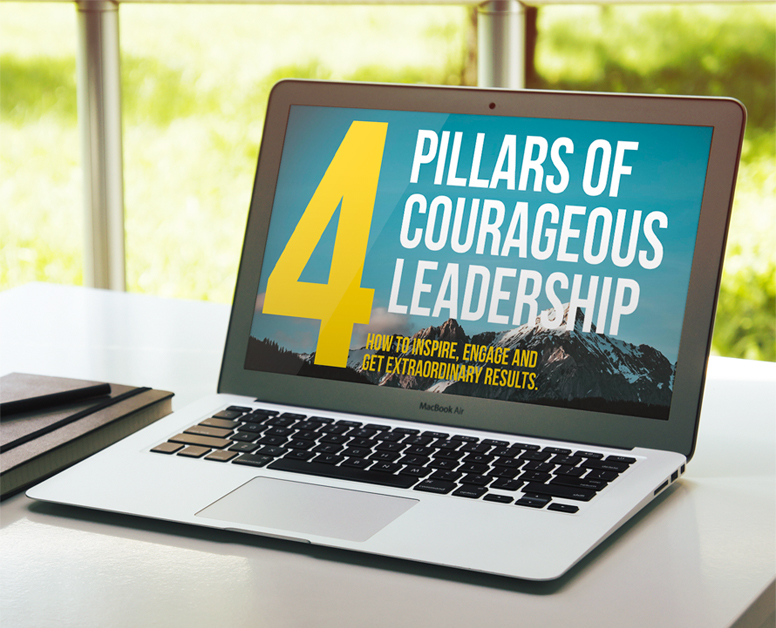 A Summary of The Courage of a Leader® 4 Pillars
A Summary of The Courage of a Leader® 4 Pillars